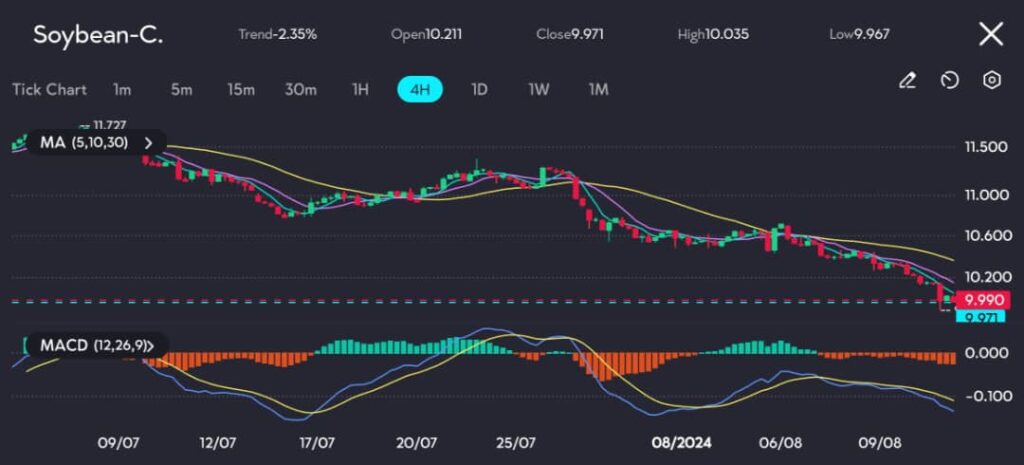Key points:
- Soybean prices drop sharply on record U.S. production forecast.
- Corn prices rise due to smaller-than-expected acreage.
- Wheat faces pressure from Black Sea competition but is cushioned by poor European crop conditions.
Soybeans took a sharp fall on Monday, with prices hitting their lowest point since September 2020. The U.S. Department of Agriculture (USDA) released a forecast predicting a record soybean production, which has sent shockwaves through the market.
Greater supply, when meeting a comparatively lower demand, typically leads to an expected drop in prices.
The Chicago Board of Trade’s (CBOT) most active soybean contract, ZS1!, dropped by 16-1/2 cents, settling at $9.86 per bushel.

Picture: Soybean prices decline as seen on the VT Markets app.
Record crop forecast sparks oversupply concerns, pressuring soybean prices
This decline in soybean prices highlights the market’s reaction to the USDA’s projection of a record-breaking 4.589 billion bushels for this year’s crop. Such a high supply forecast has raised concerns about oversupply in the market, leading to a drop in prices.
Traders and analysts will likely watch for any signs of demand picking up to absorb the excess supply, but for now, the outlook remains bearish.
In contrast, corn prices saw a rise, with the ZC1! contract increasing by 6-1/2 cents to $4.01-1/2 per bushel. The USDA’s report surprised some analysts by showing a lower-than-expected acreage for corn. Farmers in key regions like Minnesota and Iowa seem to have opted for planting more soybeans instead of corn, possibly due to the lower grain prices and higher input costs. This shift in planting has provided some support to corn prices, and the market could see further gains if the supply remains tight.
Egypt’s tender and Black Sea competition curb wheat price drop
Wheat prices faced downward pressure, with the ZW1! contract falling by 5-3/4 cents to close at $5.36-3/4 per bushel.
The decline came after Egypt’s state grains buyer disclosed offers on its largest-ever wheat tender, highlighting the competitive pricing from Black Sea suppliers.
However, Egypt only managed to purchase 280,000 metric tons, well below its 3.8 million target, due to higher-than-expected tender prices. This limited the fall in wheat prices.
European crop struggles lend support to wheat prices
Additionally, poor crop news from Europe has provided some support to wheat prices. France, a significant wheat producer, expects its 2024 soft wheat crop to be 25% below last year’s output due to relentless rain.
This drop in European production could offset some of the downward pressure from the Black Sea competition.
Also read: Wheat poised for largest monthly decline in 2 years due to harvest pressure
As the markets adjust to these developments, soybean prices are likely to remain under pressure due to the expected record supply, while corn could see support from the reduced acreage.
Wheat may experience volatility, influenced by global competition and European crop conditions. Traders will need to stay alert to any changes in these factors that could shift market dynamics.
Start trading now — click here to create your live VT Markets account.









